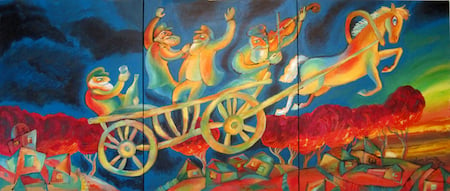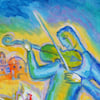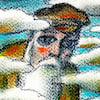Once again, Rabbi Schneur Zalman rested his head on his arms. Finally he lifted his head, opened his eyes and asked me, “How do you explain to your students the verse, ‘And Isaac trembled a very great trembling?’”
“I explain according to Rashi’s first explanation,” I replied, “that Isaac was perplexed.”
“And why,” he asked me, “do you not explain to your students what Rashi says in the name of the Midrash, that Isaac saw hell opened wide beneath him?”
“My opinion,” I answered, “is that we should not confuse the weak minds of young children with stories of aggadah in general, and certainly not with frightening matters such as hell and the like. Especially when the child might find this quite problematic: How is it possible that the great, wide hell that is a constantly flaming, burning fire for more than 5,550 years should enter Isaac’s room, while Esau with his father should remain alive, without even their clothes being singed?”
“So how, then,” he asked, “does the Midrash assert that he saw hell opened beneath him?”
I was silent and answered nothing. Obviously, I could not reply. Was this the first bit of nonsense to be found in the Midrash and Talmud?
When he saw that I had nothing to reply, he said, “Esau entered to see Isaac, and Isaac asked him who he is. Esau answered, ‘I am your son, your firstborn, Esau.’ This was a lie, because he had already sold his firstborn rights to Jacob as a complete sale, and Isaac knew of this. At this point, ‘Isaac trembled a great trembling’ over the lie that Esau had told in order to annul the laws of Torah. And since Esau was a liar, hell was truly open before him.”

Once he had concluded speaking, he leaned once again on his arms as at first. Then he lifted his head again, opened his eyes and grasped one of the two lamps that was standing on the table . . . He lifted the lamp, stared at me and said, “When a man is a resident of Vilna and says he is from Zamut; when he passes children before the fire of Molech of the ‘enlightenment’ and says he is a teacher—then hell is opened beneath him.
“How many souls have you destroyed? And you still continue in your rebellion! Yes, you have been caught in your heresy, and all who reach this point shall never return!”
The Four Departments of Torah
You can’t study literature the same way you study biology, and the same applies to Torah departments.Torah, like any wisdom, has departments. That’s important to know. You can’t study literature the same way you study biology, and you can’t critique poetry as you would journalism. So too, you can’t study one department of Torah the same as you study another.
There’s more than one way of dividing up those departments. One way is to talk about approaches to the text.2
In one Torah department, we determine the literal meaning of the text of the Five Books of Moses and the rest of the Hebrew Bible. Here, basic commentators such as Rashi, Ramban, Rashbam and Ibn Ezra are busy smoothing out the bumps as much as possible. We call that peshat—which means making things as straightforward, smooth and simple as possible.
But not so simple. Some texts will never surrender their bumps. They’re virtually screaming that they have more to say aside from their simple meaning.3 And really, every text of the Torah has infinitely more to say than its simple meaning.
So, another department looks at deeper meanings that these texts may be pointing to. Even those commentators that work their hardest to keep things as simple as possible can’t avoid stepping into this department from time to time.
Here we might discover some treasures to which the text is pointing by using similar wording in two key phrases, an extra word, peculiar phrasing or other nuances. Often, such allusions allow the Talmudic sage to determine an application of those words in practice, known as a halachah—4 or some other meaning that supplements the literal interpretation of the text. Sometimes a hint is provided by gematria, the numerical value of words. This approach of interpreting allusions and nuances is called remez.
Finding deeper meaning and lessons in life is yet another department, which we call derush or midrash—and our basic commentators will again be found in these halls as well. Midrash often includes stories, called aggadah, some allegorical, some anecdotal, some reaching far beyond what we understand to be possible in our world. Midrash can be found strewn throughout the Talmud, and in many anthologies compiled contemporaneously with the Talmud or later. The largest, best-known collection is called Midrash Rabbah.
The text bubbles with meaning, frequently defying the steamroller of the strict literalist, demanding deeper interpretation at every turn.Many of the juiciest midrashim are collected in the classic commentary of Rashi.5 This despite Rashi’s repeated insistence that “I come only to explain the simple meaning of the text.” Because the text bubbles with meaning, frequently defying the steamroller of the strict literalist, demanding deeper interpretation at every turn.
Then there’s the secret meaning, the interpretation you would never know unless it were revealed to you. We call that sod, also known as Kabbalah.
Here, too, you’ll find those same masters of simplicity. Ramban was probably the first to reveal such secrets to the general reader in his commentary. The Ohr ha-Chaim commentary of Rabbi Chaim ibn Attar reveals much more, yet still in a language accessible to the general reader. In the commentary of Rashi you’ll also find such secrets—only that you’ll have to look hard to unearth them there.6 Indeed, very few of the classic commentaries are without frequent reference to “the hidden wisdom,” whether openly or between the lines.
The Orchard of Torah
Rabbi Yitzchak Luria, the Ari, constructs an acronym from these four departments, disciplines, or levels of peshat, remez, derush and sod: pardes, meaning “an orchard.” He taught that every soul must delve into all four layers of the Torah, and must continue to return to this world until having done so.7
| Department | Hebrew | Reveals . . . | Belongs to . . . |
|---|---|---|---|
| Peshat | פשט | Simplest meanings | World of Action |
| Remez | רמז | Hinted meanings | World of Formation |
| Derush | דרוש | Deeper meanings | World of Creation |
| Sod | סוד | Secret meanings | World of Emanation |
The Ari explained just how vital is this obligation:
Know that the entirety of all the souls is 600,000 and no more. [The Ari is speaking of general souls, which include within them many more souls.]8 Now, the Torah is the root of all Jewish souls, for from there they are hewn and within it they are rooted. Therefore, in the Torah there are 600,000 explanations—all of them according to peshat. There are also 600,000 explanations in remez, 600,000 in derush and 600,000 in sod. So, we find that for every explanation of the 600,000 explanations, one Jewish soul comes into being.
In the time to come, every Jewish person will grasp the entire Torah according to the explanation that matches the root of his soul—as we said, it was from this explanation that this soul was created and brought into being.9
It’s rare that Kabbalah has a direct impact on halachah, but the Ari was also an expert authority in Jewish law, and is often the exception in this regard. This is one instance. In his Laws of the Study of Torah, Rabbi Schneur Zalman of Liadi codified as law this obligation to delve into all four levels of Torah. After delineating what exactly is included in the obligation upon every Jew to learn and to teach his child “the entire Torah,” he concludes:
The sages of the Truth [Kabbalah] say further that every soul, for its tikkun, must delve into all of Pardes according to whatever it is capable of comprehending. Anyone who is capable of comprehending and knowing much, but through his own laziness grasps but a little, must return through the cycle of reincarnation until he grasps and knows all that is possible for his soul to grasp of the knowledge of the Torah, whether in the simple meaning of the laws, or whether in the allusions, derush and secrets.
This is because all that your soul is capable of comprehending and knowing of the knowledge of Torah is a tikkun for its wholeness. Without this knowledge, it is not possible for it to repair itself and perfect itself in its bond of life with G‑d, at the very origin from which it was hewn.
That is why the sages said about the world to come, “Fortunate is he who comes here and his learning is in his hand”—for then he will not need to return again through the cycle of life into this world.
The Wholesome Torah Diet
You can’t satisfy your requirements in one department alone. You need a well-rounded curriculum.The Ari’s message is not as esoteric as it may seem: Just as our bodies do not live by carbs alone, so our souls require a mixed diet. To be a complete Jew embracing a complete, wholesome Torah, you can’t satisfy your requirements studying in one department alone. You need a well-rounded curriculum at all four levels.
Your firm foundation is your knowledge of the basic text of the Jewish people with the traditional commentaries of Rashi, Ramban, Rashbam, Ibn Ezra and others who explain their simplest meaning. You keep your daily life connected to that foundation with a good grasp of the dos and don’ts of halachah—not just what they are, but where their roots lie.
And the midrashic tales and the secrets of the Torah are just as vital. Why? Because as much as Torah is about what you know and what you do, it’s also about how you think and what you feel. As magnificent a structure as you may have built for yourself, without light and warmth nobody is going to live there too long. That’s the way life goes: without the sparks firing, the engine just stops turning.
Midrash is your gateway to connect with the Author of the Torah. “If you want to know the One who formed the universe,” the Talmudic sages advise, “learn aggadah.”10 Aggadah, the midrashic tales scattered throughout Torah literature, are said to contain “most of the secrets of the Torah.”11
But the secrets are veiled, as Maimonides writes (we’ll get to that soon), so that only those who are fit to receive them will discover them there. The Zohar provides a parable to explain why the Torah must speak in parables:
She was beautiful in appearance, beautiful in form, and she hid herself within the secrets of her palace.
She had but one lover. No one knew of their love. No one but she, secreted away in her hiding place.
Driven by his love, her lover would be drawn to the door of her house, his eyes scanning the building as he passed, examining every corner, searching for her there, for just a glimpse of her.
And she knew he was there. But what could she do so that only he would find her, and no one else?
So she opened a small window to that secret place where she hid within her palace, and—just for a brief moment—she revealed her face to him. And then she returned and hid again.
None of those who were there with her lover saw her. None cared to look. Only her lover saw. And his innards, his heart and his soul were pulled after her. For he knew that it was out of her love for him that she had revealed herself to him for a moment, to arouse him to love.
So far, it seems these secrets are only for the committed lover who has the wisdom to get the first hint. But in the subsequent passage, the Zohar speaks of those who have love, but must take a few more steps to acquire wisdom.
. . . Come and see! This is the way of Torah: At first she permits herself to reveal herself to people, hinting to them in the flash of a moment. The one who knows, knows. The one who does not—she turns her back to him, and she calls him a fool.
And then the Torah says to this person to whom her back is turned, “Tell that fool that came here that I will speak with him.”
This is what is meant by the verse (Proverbs 9:4), “Who is the fool who turns here, lacking a heart? She speaks to him.”
He comes close to her. She permits herself to speak with him, but from behind a curtain. She speaks words according to his understanding, until he sees little by little.
This is midrash.
Next, she speaks with him from behind a thin veil. She speaks in riddles.
This is aggadah.
The Zohar sees midrash as the portal to the secrets of the Torah. The Zohar sees midrash as the portal to the secrets of the Torah.Those who do not love the Torah are not fit to receive its secrets, so the Torah must speak in riddles and hints. Those with love and wisdom in their hearts grasp the secret immediately. Those with love, but lacking wisdom, work their way to the truth step by step. But those with neither love nor wisdom simply haven’t a clue what’s going on.
But the Zohar’s parable does not end there. Eventually, this lover of Torah becomes a “master of the house,” in consummate marriage with the Torah:
Eventually he becomes familiar with her, and she reveals herself to him face to face. She speaks all her hidden secrets with him, revealing all the hidden pathways that were in her heart, hidden from the earliest days.
This person who has attained wholeness, who has become the husband of the Torah, is now certainly a master of the house. For all her secrets are revealed to him. She does not distance herself, or hide from him anything at all.
She says to him, “See the mysterious words that I hinted to you at first? See how many secrets were there? Now I will tell you what was meant.”12
The Empress’ Clothing
Note those last lines: Even once the lover of the Torah has mastered all of her secrets, she still reminds him of the “mysterious words” of the Midrash and its aggadah. But why is that? If he already grasps the secrets those stories hide, why can’t he discard the packaging in which they came?
Apparently, the stories and mysterious words are more than packaging. After all, as the parable of the Zohar tells, from within the cloak of these parables the inner soul of the Torah speaks. Perhaps we should think of these stories as haute couture for G‑d’s wisdom. They are the fine clothing and jewelry that allow expression for Torah’s most inner wisdom, as a tasteful wardrobe betrays beauty that would otherwise elude the senses.
So fitting, so magnificent is this wardrobe that it carries the secrets of Torah even to the small child. In a way, it transmits to the simple child much more than to the sophisticated adult. To the adult, the clothing is distinct from the meaning it contains; the analogy and its analogue live in two different worlds. The child, when he grasps the clothing, grasps the warm body and soul breathing within. They are all one and the same. In his simple understanding of the tale, he touches G‑d.
To better understand how that is so, we’ll have to examine midrash a little deeper. We need to ask, are the stories of the Midrash truth or fiction? If they are truth, how is it that they so often conflict with one another? And how do we know when the Talmud is telling us a historical anecdote and when it is speaking in parables?
To answer those questions, we’ll look at some of the controversy that surrounded midrashic tales historically, and how the most brilliant of the rabbis dealt with those controversies. All in the coming installments.









The hell that opened up was the division of the upper waters from the lower waters of hell which is codified in the 40 and 30 weeks the books of the prophets excluding the 12 minor prophets. This was a spiritual understanding of Isaac not literal fire. He “saw” Esau fall.